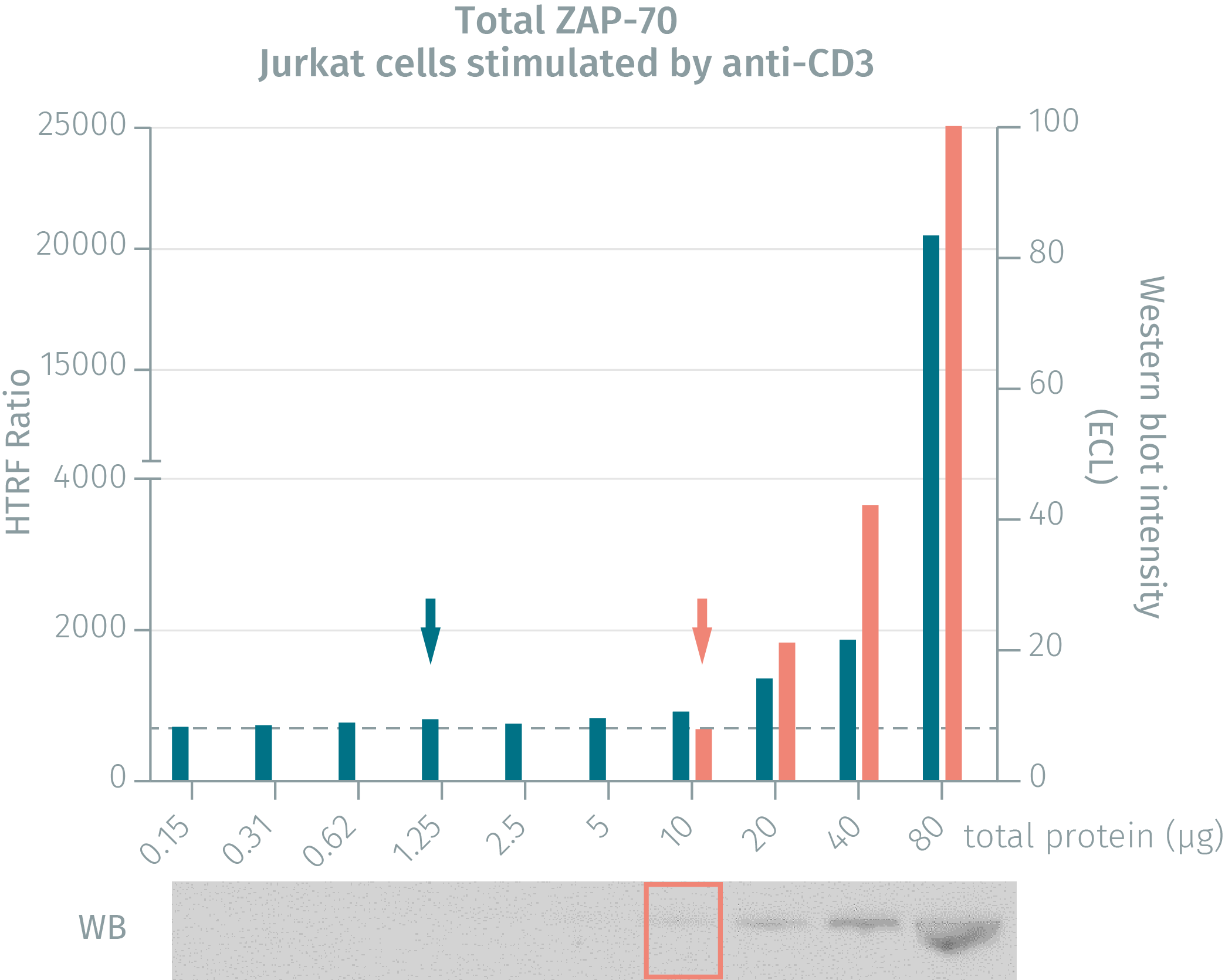

HTRF Human Total ZAP-70 Detection Kit, 500 Assay Points






The total ZAP-70 kit detects cellular ZAP-70 and can be combined with our phospho-ZAP-70 kit for an optimal readout of the Hippo-YAP pathway.
For research use only. Not for use in diagnostic procedures. All products to be used in accordance with applicable laws and regulations including without limitation, consumption & disposal requirements under European REACH regulations (EC 1907/2006).
Product information
Overview
The Total ZAP-70 cellular assay is designed to monitor the expression level of ZAP-70 proteins, both phosphorylated and unphosphorylated. It is compatible with our phospho-ZAP-70 kit and enables the analysis of phosphorylated and total proteins from a single sample for a better readout of T-cell activation. ZAP-70 is a cytoplasmic protein tyrosine kinase expressed in T and NK cells, and plays a critical role in the events involved in initiating T-cell responses by the antigen receptor.
Specifications
| Assay Points |
500
|
|---|---|
| Assay Target Type |
Kit
|
| Assay Technology |
HTRF
|
| Brand |
HTRF
|
| Quantity |
1
|
| Shipping Conditions |
Shipped in Dry Ice
|
| Therapeutic Area |
Oncology & Inflammation
|
| Unit Size |
500 Assay Points
|
Video gallery


How it works
Total-ZAP-70 assay principle
The Total-ZAP-70 assay quantifies the expression level of ZAP-70 in a cell lysate. Contrary to Western Blot, the assay is entirely plate-based and does not require gels, electrophoresis or transfer. The Total-ZAP-70 assay uses two labeled antibodies: one coupled to a donor fluorophore, the other to an acceptor. Both antibodies are highly specific for a distinct epitope on the protein. In presence of ZAP-70 in a cell extract, the addition of these conjugates brings the donor fluorophore into close proximity with the acceptor and thereby generates a FRET signal. Its intensity is directly proportional to the concentration of the protein present in the sample, and provides a means of assessing the protein’s expression under a no-wash assay format.

Total-ZAP-70 2-plate assay protocol
The 2 plate protocol involves culturing cells in a 96-well plate before lysis then transferring lysates to a 384-well low volume detection plate before adding Total-ZAP-70 HTRF detection reagents. This protocol enables the cells' viability and confluence to be monitored.

Total-ZAP-70 1-plate assay protocol
Detection of total ZAP70 with HTRF reagents can be performed in a single plate used for culturing, stimulation and lysis. No washing steps are required. This HTS designed protocol enables miniaturization while maintaining robust HTRF quality.

Assay validation
HTRF assay compared to Western Blot using ZAP-70 cellular assays on human Jurkat cells
Jurkat cells were grown in a T175cm2 flask for 2 days in RPMI culture medium supplemented by 10% FBS, at 37°C in 5% CO2 atmosphere. 4.5 ml of cell suspension (13 x 106 cells / mL) were stimulated with anti-CD3 antibody (20 µg / mL final concentration during 2.5min). After stimulation, cells were lysed at RT for 30 min by adding 2.25 mL of 4X supplemented lysis buffer. Neat lysate was then serially diluted in the same supplemented lysis buffer. 16 µL of each dilution were analyzed in parallel by HTRF or Western Blot

Kinetics of cell stimulation - Total ZAP-70 assay
This assay was performed using the two-plate assay protocol. Jurkat cells were plated in a 96-well culture plate at 400 K cells, using 25 µL / well in complete RPMI culture medium with 10% FBS. Cell stimulation was performed using the anti-CD3 Ab at the final concentration of 20 µg / mL for different stimulation times (min). After stimulation, cells were lysed with 10 µL of 4X supplemented lysis buffer. 16 µl of each cell lysate type were analyzed with the HTRF total ZAP-70 assay.

Monitoring of the immune checkpoint inhibitor PD-L1 activity
As Phospho ZAP-70 (Tyr319) is a readout of T cell activation, it was used to monitor the inhibitory effect of PD-L1 recombinant protein on T cell activation. This assay was performed using the two-plate assay protocol. 400 000 Jurkat cells were plated in 25 µL of complete RPMI culture medium with 10% FBS in a 96-well culture plate. Cells were pre-incubated 24 hours with different concentrations of PD-L1 recombinant protein. Cells were then stimulated for 2.5 min with 20 µg / mL anti-CD3 Ab (final concentration) and lysed directly with10 µL of 4X supplemented lysis buffer, then incubated 30 min at RT. 16µL of each sample were analyzed using Phospho ZAP-70 (Tyr319) and Total ZAP-70 assays. Phospho ZAP-70 results were normalized with the Total ZAP-70 amount and plotted on a graph. A slight but significant inhibitory effect of PD-L1 recombinant protein was recorded with the Phospho ZAP-70 (Tyr319) assay at the final concentration of 40 µg / mL.

Simplified pathway
Function and regulation of ZAP-70
TCR engagement promotes the phosphorylation of immunoreceptor tyrosine-based activation motifs (ITAMs) on the cytosolic side of the TCR/CD3 complex by lymphocyte protein tyrosine kinase (Lck). Zap-70 is recruited to the TCR/CD3 complex where it becomes phosphorylated and activated, promoting recruitment and phosphorylation of downstream adaptor or scaffold proteins.

Resources
This guide provides you an overview of HTRF applications in several therapeutic areas.
Study your pathway of interest in PBMC and T cells
Combine models with a technique that maximizes each one’s relevance: this note...

SDS, COAs, Manuals and more
Are you looking for technical documents for this product. We have housed them in a dedicated section., click on the links below to explore.


How can we help you?
We are here to answer your questions.






























